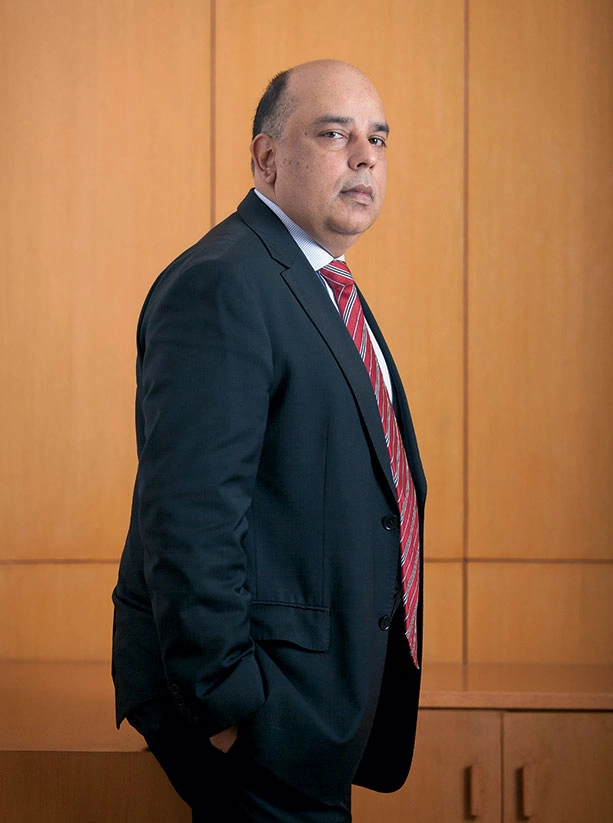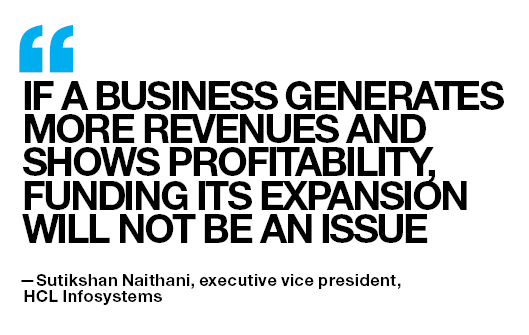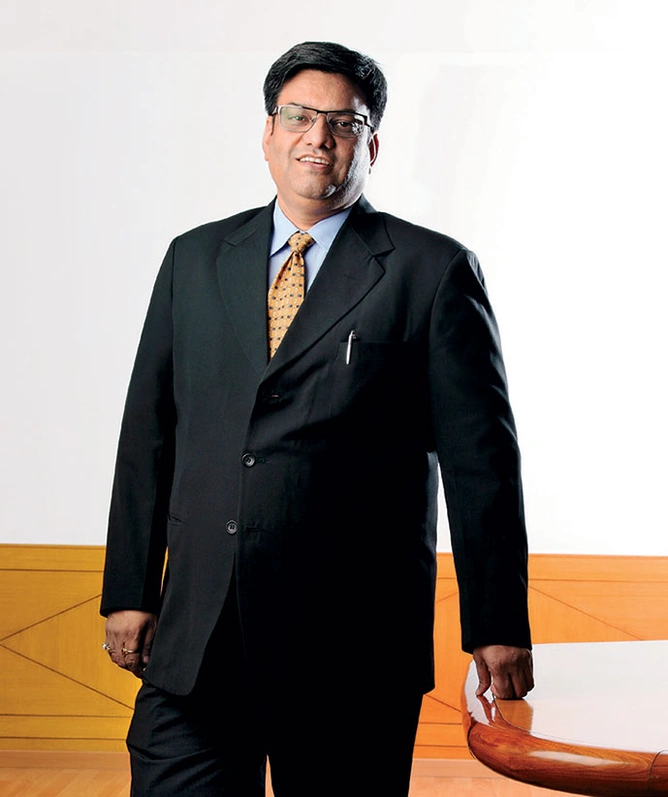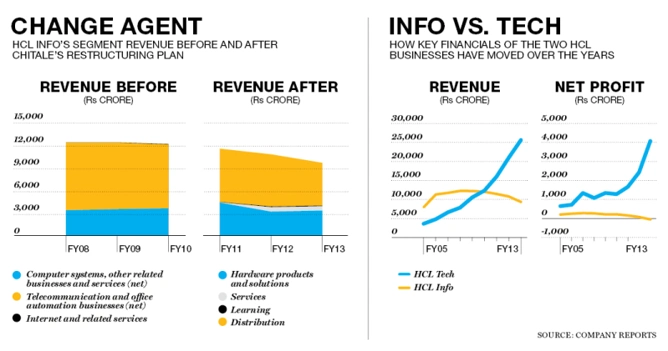INDIAS'S IT INDUSTRY has never lacked stars. Folks like N.R. Narayana Murthy, Azim Premji, and Shiv Nadar have founded technology behemoths, and repositioned India in the world. Beyond the founders, there are also star managers, the likes of S. Ramadorai and Vineet Nayar. One built a Tata powerhouse, while the other executed a sweet turnaround. Harsh Chitale, though much younger at 42, could be one such worthy in the future, if only he can sort out his present. Unknown and self-effacing, Chitale is tasked to remake India’s first PC maker, HCL Infosystems. It is a pretty ambitious task, given the legacy of Nadar, HCL’s celebrated founder.
Thirty-seven years ago, Nadar and five colleagues hatched the idea of HCL at the canteen of Delhi Cloth Mills, their employer at the time. They were young (Nadar was 30) and edgy. Soon HCL built the 16-bit computer, before Apple could ship one. Three years on, it sold “computerisation”—hardware, software solutions, and services bundled into one—in Singapore. Next, Nadar entered and exited IT education (NIIT), while HCL Info made personal computers. Within a decade, HCL was one of the largest IT companies in India.
According to reports, a setback in the U.S., when HCL computers failed to clear environmental norms, changed the narrative. In 1995, Nadar handed over the reins to co-founder Ajay Chowdhry and started HCL Technologies two years later. Nadar had turned to software. Chowdhry, who was driving HCL Info’s international marketing, returned and started a distribution business here. He signed a deal with Nokia to sell handsets. Things were good for over a decade, but thereafter HCL Info started going downhill, dragged down especially by Nokia’s diminishing market share. Between 2008 and 2010, sales slipped by Rs 24 crore (to Rs 12,400 crore) and profits plunged 20%. In 2009, when Chowdhry decided to retire, HCL Info was up for change.

Chitale joined in December 2010, and in three years has retooled HCL Info. He has broken up the company into five subsidiaries—and stopped making computers. It was an emotional call—hardware manufacturing was always core to HCL Info and Nadar. Chitale followed what IBM did in 2005 when it sold its hardware business to Lenovo. Later, Wipro Infotech would follow suit. Emotions couldn’t justify running computer factories which added very little to its revenues. Nevertheless, Chitale says he is ready to keep the brand alive by sourcing products as well as licensing out the name. “Many companies are willing to carry our brand on their products and use our sales and distribution network to get into India. That suits us fine.”
The subsidiaries Chitale created are HCL Systems Integration for hardware solutions; HCL Care for large, long-term, managed IT services, office automation, and third-party annual maintenance; HCL Learning for the business of education; telecom distribution under HCL Infosystems; and distribution of non-telecom products under Digilife Distribution and Marketing Services. The new structure will easily identify the business that is doing well, and where investments are required. “If a business generates more revenues and shows profitability, funding its expansion will not be an issue,” says Sutikshan Naithani, HCL Info’s executive vice president.
The restructuring also opens up possibilities like selling a part of the business or assets. “Any part of the business is available at the right price, but we are not discussing yet,” says Chitale. That’s for the board to decide, he adds. Overall, Chitale’s got it all figured. He aims to double the distribution business to more than Rs 11,000 crore, take services to Rs 2,500 crore from Rs 600 crore now, and grow HCL Info five times in the next five years. “From 2014 we start with a clean slate and a new strategy. For the good news to flow, give me three more quarters,” says Chitale.
Meanwhile, the company continues to slide. For the first time, it posted losses—Rs 80 crore on a Rs 9,000 crore turnover for FY13. At the time of writing, the stock traded at Rs 28, down from Rs 117 in December 2010. That’s Rs 2,000 crore of shareholder value eroded.
It’s been nearly 20 years since Nadar stopped being involved in HCL Info’s operations, preferring a more visionary role for himself. However, as shareholder, Nadar’s shadow looms over Chitale and his men. He directly, and indirectly through HCL Corporation, holds close to 50% of HCL Info. (HCL Info and HCL Tech make up the two business arms of HCL Corp. The rest is philanthropy.) He is consulted and briefed at least every quarter. “We have a responsibility as the owning company [HCL Corp]. Earlier we did not exercise it. In a board meeting in November we decided that we need to be responsible because there are many expectations from other shareholders and employees of the company [HCL Info]. We will do whatever is required of us as a promoter,” says Nadar, clarifying his involvement.
No one’s writing the company’s obituary yet, though talks of it being sold or merging with HCL Tech have been doing the rounds. (The HCL management denies it as speculation.) But last year Nadar increased his shareholding by almost 7%. This could mean he is confident of a turnaround and, therefore, accumulating more stake, or he is readying for good returns if the company or its businesses get a valuation. Nadar says he has “no intention of completely exiting HCL Info”. For now, having the promoter on his side is perhaps the biggest assurance for Chitale.

HARSHVARDHAN MADHAV CHITALE was born in 1972 in Mumbai. In 1984, when his father, an engineer with the Ministry of Water Resources, moved to Delhi, Chitale joined Delhi Public School (DPS), R.K. Puram, in Class VIII. There, Chitale had to work hard on English. Till then he’d studied in a Marathi-medium school because his traditional parents did not want a Western influence early in life. For his first scholar badge ceremony at DPS, Chitale saw his mother sitting at the back while parents of those who had scored well were in front. He decided his parents would also sit in the front the next year. In six months Chitale topped his class, (though his marks in English showed strains). “I’ve set targets since childhood. It is helping me now,” says Chitale.
In 1989, he joined IIT Delhi and topped in electrical engineering. A gold medallist, Chitale cleared the entrance for IIM-Ahmedabad twice, but chose to join TAS, formerly Tata Administrative Services, a leadership programme under the Tata Group. Rothin Bhattacharyya, chief strategy officer at HCL Info, says, “Harsh has always been a person who would not just do different things, but do things differently.” Chitale says TAS was like doing multiple MBAs simultaneously—he interned with Indian Hotels, Tata Telecom, Telco (now Tata Motors), and Tata Honeywell, a joint venture between the Tata Group and Honeywell International, Inc. Out from TAS, he joined Tata Honeywell as products manager and was group business head within a year. By 33, he was the youngest managing director in the history of Tata Honeywell. Among colleagues, almost all of whom were older, Chitale learnt to manage, delegate, and importantly, not hurt egos. “In a tech firm, leadership comes by thought and not age. Harsh was not old or experienced. What mattered was his thought leadership,” says Vinayak Kashinath Deshpande, managing director, Tata Projects. Chitale worked under Deshpande at Tata Honeywell. After the Tatas exited the joint venture, he joined Honeywell International. By 35, he had orchestrated eight acquisitions there.

The rise caught Nadar’s eye. He was looking for someone who had the knack for developing business and was young, and therefore, could invest time to grow one. For Chitale, HCL Info seemed familiar: Everyone was older. “The first thing Harsh did was drop the ‘sir’ culture. He didn’t want older colleagues to call him that,” says George Paul, vice president-service delivery at HCL Info. Paul has been with the company for 30 years and seen its cultural transition. He adds that Chitale has bridged the gap between old and new, and managed to control attrition at around 16%, below the tech industry’s average of 18%.
Beyond manner of address, HCL Info’s survival was Chitale’s immediate challenge. Nokia was the big risk. HCL Info is the phone company’s sole distributor, with half its revenues coming from there. A renewal of contract with Nokia was coming up in six months. Under the contract, HCL Info developed a deep, nationwide dealer network and pushed Nokia handsets through its sales force. It was a margins business—HCL Info would buy the handsets from the phone maker and sell them to retailers at a profit. However, smartphones and Android invasions had been eating away Nokia’s market share—by 2010, it had shrunk to 35% from 58% in 2007. The question before HCL Info was, if Nokia collapsed, what would it do with the distribution built to support it. Nokia has stuck with HCL Info.
However, Chitale has de-risked the business by expanding into non-telecom products under Digilife, though that has meant building a separate distribution network. Riding on Digilife’s reach in 15,000 towns and cities, Chitale is pushing to increase the range of consumer electronics and home appliances being distributed. The company already distributes home appliance brands such as Braun and De’Longhi, and electronics from the likes of Lenovo and Karbonn. “Some bigger brands are joining,” says Naithani. He doesn’t reveal names, as deals are under way.
Products distribution in India is a Rs 1.5 lakh crore market, occupied largely by unorganised players. The rest are a handful of companies, such as HCL Info, whose distribution arm has a revenue of Rs 6,000 crore; and supply chain solutions provider Redington. Margins in this sector are not very high, about 3%, but it has a good return on capital employed (ROCE). Against the competition’s 30%, HCL’s ROCE is 70% due to the efficiencies it has built over the years.

HCL Infosystems.
Two years ago, Redington India co-founder and managing director R. Srinivasan told Fortune India that he saw a lot of opportunity in this business. “Given India’s growth, there is room for a couple of Redingtons in several areas,” he had said. Chitale too, feels there is enough headroom for HCL Info to grow as it diversifies beyond Nokia. He expects half of the distribution revenues to come from non-telecom business in the next four years. “Our ambition around telecom is not very high,” says Bhattacharyya. HCL Info is now relatively less exposed to the sector, with other categories growing by 25%, he adds. But the risk here is that tech obsolescence is high in electronics and IT, and could suffer shocks if global business trends change.
Meanwhile, Chitale was also figuring out how to de-risk HCL Info’s Rs 1,500 crore systems integration business. This business relied largely on public sector telecom companies BSNL and MTNL. By mid-2010, MTNL, along with other government agencies, had been pulled into a monetary scam over Commonwealth Games projects. That, plus the fact that both MTNL and BSNL shelled out a whopping Rs 12,500 crore for 3G licences auctioned in 2010, meant there was no money to pay suppliers, including HCL Info. Some Rs 1,200 crore of payment to HCL Info was stuck. “Companies overestimated government contracts,” says Nilaya Varma, managing director (management consulting), Accenture. Bottom line: HCL Info was hit.
Chitale has now de-risked the business by adding IT services to it. In India, IT services is a Rs 50,000 crore market, less than half of which is BPO and consulting—areas where HCL Info is absent. It wants to build IT infrastructure and service networks—a sort of nuts-and-bolts job—mostly for private companies. Its portfolio of 400 customers has already shifted, with less than 40% now government projects. Chitale expects the business to grow in double digits in the next five years. “Companies like IBM or Wipro depend on franchises or partnerships to win these deals. HCL Info will be a one-stop shop.” He, however, does not rule out being a partner or franchise. In this space, margins range between 15% and 35%, though ROCE is not similar to distribution. Here, HCL Info’s prize catch has been the Unique Identification Authority of India’s Aadhaar project, which it won against TCS, Tech Mahindra, IBM, and others.
Chitale’s big bet is on the learning business. HCL Info is creating digital education content for schools as well as professional courses, and distributing it through its own-branded low-cost tablets, and the Internet. It is a Rs 100 crore business, up from Rs 24 crore two years ago, and has the highest margin among all its businesses. It has also acquired education content provider Edurix to develop and customise content. There’s more. Within the HCL family, it is developing interactive content till Class V for HCL Foundation’s project Shiksha—Nadar’s new passion.
IN HCL, PEOPLE SAY Chitale could be the next Vineet Nayar. When HCL Tech was slipping against TCS, Wipro, and Infosys, Nayar put it back among the top four Indian IT companies. In the first four years of his leadership between FY05 and FY09, HCL Tech grew by 200% and profits increased 53%. Chitale is expected to do something similar.
To compare both, their performances have to be put in perspective. When Nayar took over HCL Tech (he was CEO till January 2013), the firm lacked direction. It had missed the bus on high-value financial services solutions and failed to retain or attract talent. In a way, the problem was organic. Nayar looked for out-of-the-box solutions and caught the imagination of both customers and employees with phrases like “employee first, customer second”. The bidding war with Infosys for British consultancy firm Axon in 2008 also painted him as an aggressive manager willing to compete with global players. Nayar snatched away Axon at the last moment by offering £34 million (Rs 351.5 crore at current rates) more than Infosys.

HCL Info suffered due to external factors, such as overdependence on the state. In addition, volatile exchange rates affected hardware imports in a turbulent economy. Basically, while HCL Info tried drawing its stability from the public sector, HCL Tech ventured into the top-dollar MNC space. There was risk, but Nayar would say, “HCL [Tech] is competing against IBM and Accenture for global customers, and not with any Indian IT company.” Even when Nadar was at the helm, HCL Tech focussed on cutting-edge solutions for Boeing, Johnson & Johnson, Autodesk, etc. Jaideep Mehta, vice president and country general manager, IDC, sums it up right: “HCL Info was caught in the middle of a bad phase for IT product companies. It still has a role in systems integration, minus the hardware.”
Chitale’s going the Nayar way with software solutions. “HCL Info has leapfrogged into next-gen emerging technologies. These are the hottest things around, where we have no disadvantage and everyone is new,” he says. HCL Info plans to expand its team of 1,000 software professionals for cutting-edge software application development and high-end big data analytics. The changed strategy pits it against not only traditional IT services players, but even its own kin, where it is likely to face stiff competition.
Bhattacharyya, however, says no IT services company can be a scale player like HCL Info in India, as they are too geared towards catering to Western and mature markets. “India is a test case with huge databases, and challenges you to be low-cost and operate on thin margins. It is an art rather than a science.” He explains that creating a public project like India’s unique identification drive may work in emerging economies in West Asia or Africa which have similar conditions. The same template will not work in a developed economy like the U.S., he adds. “I am not going to compete in the U.S. or Europe. I know where my expertise will work.”
Chitale will hope his plans work. If they do, HCL Info will go down as one of the best turnaround stories. All he needs is a bit of luck, and perhaps some fairy dust.










Leave a Comment
Your email address will not be published. Required field are marked*